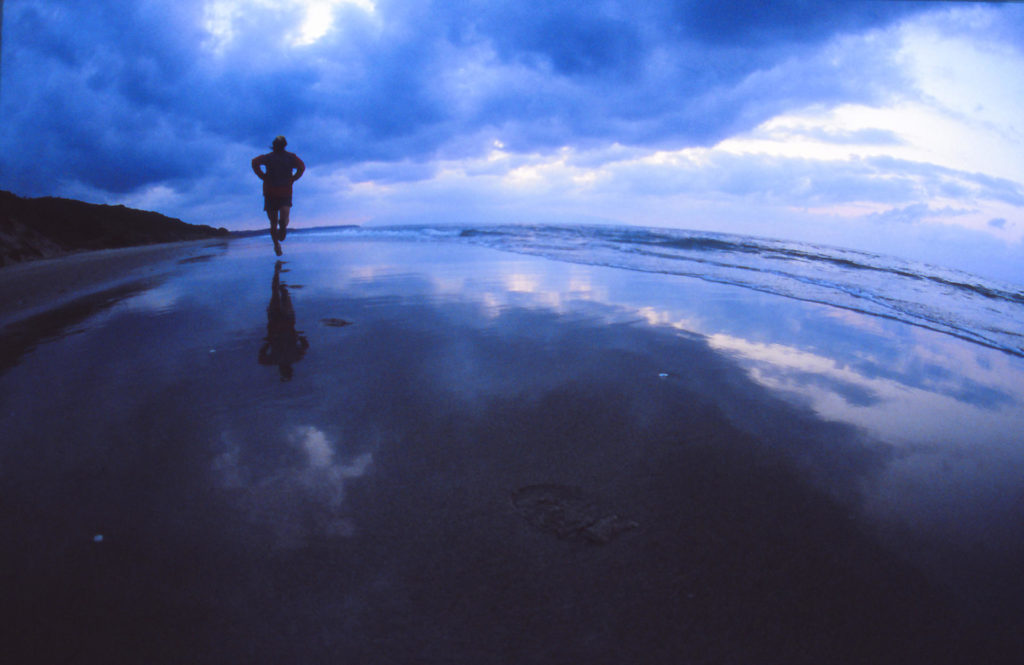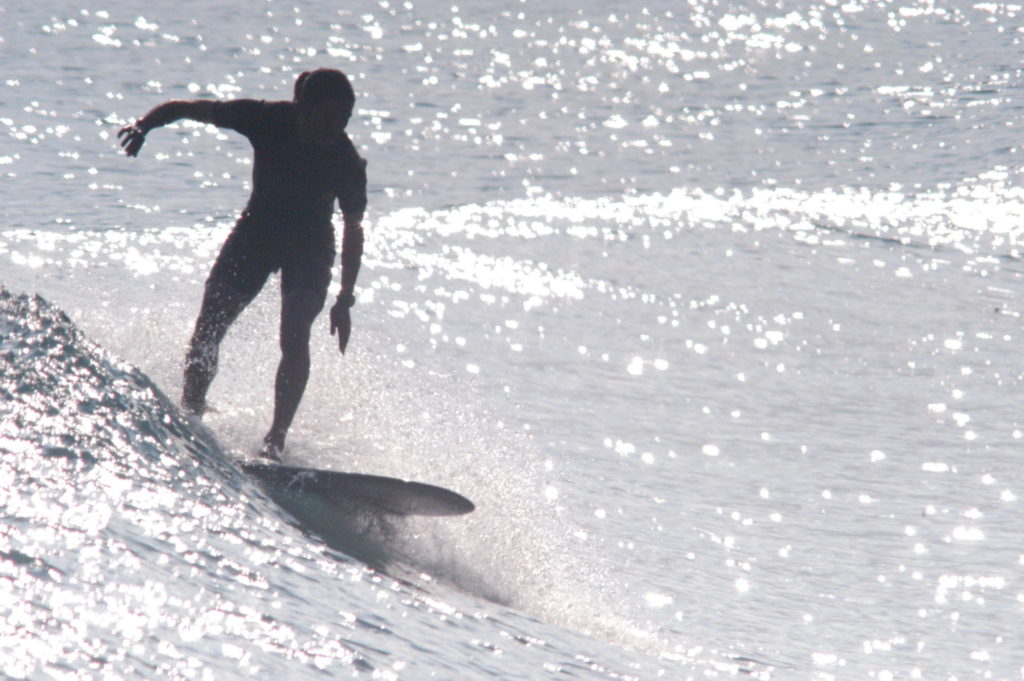Hiroki Ishikawa is one of Japan’s top trail runners, competing regularly in Japan and overseas. It’s been three years since he last came to my home in Tanegashima to surf, but I recently caught up with the “light-footed” runner to talk about how he has evolved as an athlete and a person since I saw him last.

Mitsuharu Kume: What have you been up to since the last time I saw you?
Hiroki Ishikawa: I wanted to make the surfing trip to Tanegashima an annual event, but it’s been hard to get the time. There’s been a trail running boom for the past four to five years, and I’ve been busy organizing races. I often say this but, as the numbers grow, so do the problems.
People play in the mountains for many reasons; some hike, climb or run, and it’s always a problem when they don’t treat the environment with respect. Since the boom began, many times we’ve had more entrants for races than places for them. Race courses set along regular mountain climbing trails can get crowded and chaotic; tree roots and trails can get damaged.
I’m also an athlete, so I take part in many races overseas. Perhaps more than anyone else here in Japan, I have the chance to see other races. I want to raise the quality here and come up with races that fit well with the conditions in Japan. I’m involved with races all over the country, trying to come up with new ideas.

K: I first heard of the word “trail running” when I met you. How did you first encounter the sport?
I: Since I was very young, I played soccer and dreamed of becoming a professional soccer player. Later I got into reggae music and started buying vinyl records—I still do today—and got a part-time job in a club. I joined a soccer team with some friends who also liked music and, through them, I first heard about adventure racing.
I liked mountain biking too, but I was drawn to the simplicity of running, as you don’t need a lot of equipment to compete. There were mountain marathons and other races back in those days, but I wasn’t aware of them. I lived near Mt. Tanzawa in Kanagawa Prefecture and, for two or three years, I just sort of ran alone in the mountains, discovering the different kinds of mountains and trail running.
K: What do you think about when you’re running?
I: It depends on the course, but usually I try to read what’s ahead, imagining what lies around the next curve. But there are times when I’m thinking about work, too. It’s the same as when I’m surfing.
K: Are there similarities between surfing and trail running?
I: The main thing is you’re playing on a natural “field” away from the city. You may go to the same place, but each time things will be different because of the season, the weather or even the time of day. That’s what I like about both, and—simply—both are fun.
K: Do you have a favorite season?
I: Trail running in winter is the most fun. There are a lot of mountains in Japan, so you spend a lot of time running through the woods. When the trees have lost their leaves, the field of vision gets much wider, which makes running a lot more pleasant. It’s also softer on the feet when there are leaves piled-up to run through. There’s not much you can do in summer when it’s hot but, when it’s cold, moving warms your body.

K: Have you encountered animals on the trail?
I: Occasionally bears, both in Japan and overseas. It’s funny, the first time my thought was, “All right! I finally met a bear!” Later on, though, when I cooled down, it was more like, “Whoa, that could have been dangerous!” But I’ve never been attacked or anything. The most dangerous thing would be a sudden encounter. It’s like how you might swing out at a fly if it suddenly flew in front of your face; if you were to suddenly encounter a bear, it might lash out at you just to protect itself.
That’s why it’s important in trail running to use all your senses. Not just bears, but also kamoshika and inoshishi have very strong scents, so you have to use your nose to pick up the smells, your ears to hear the animals’ noises and try to sense if animals are there. Clapping your hands or calling out in a loud voice lets them know you’re there; they don’t want to meet you in the woods, either.
A kamoshika actually helped me once. I was running on this old trail at about 2,500 meters. It was raining and I was alone, not really thinking. I came to a fork in the path and thought, “This way must be right,” choosing one of the paths, but suddenly a kamoshika cried out, like he was telling me, “That’s not the right one!” So I turned back and took the other path, which was correct.
K: What kind of trouble can a runner get into on a trail like that?
I: You could say trail runners, like marathoners, are expert runners. However, to say all trail runners are fast wouldn’t necessarily be correct. In fact, I think baseball players make good trail runners because they can react quickly. Trail running requires you to constantly react to the conditions on the trail. When I run, my goal is to cover the trail like a flowing river, quietly placing my feet without disturbing the trees or rocks. Ultimately, though, I want to run like an animal.
K: Injuries are a part of any sport. Have you had any serious ones?
I: Not really. I guess I have good balance, so I don’t fall often. But I did have a bad fall last year, the worst so far. When you let your senses down, you are more likely to get injured. I usually get my body warmed up, then gradually increase the pace, staying in tune with my body as I’m running. The day I got hurt I was working, so I didn’t warm up and started going too fast too soon. Then it just happened…
K: Do you train every day?
I: I consciously make time to rest but, even on rest days, I’ll do something to get my heart rate up. It may just mean running home from the station—something to remind myself I am an athlete.

K: Is there anything about trail running in Japan you’d like to share with our overseas readers?
I: I think the main thing is the technicality of Japanese trails. Many of the trails overseas are serviced very well, so they’re easy to run on, and the danger is low. Some may feel it’s a negative but, in Japan, the trails aren’t maintained very much. The nice thing is the trails are much more natural, and nearly all the trails here go to mountain summits. So you usually have fantastic views when you finally reach the peak.
K: What’s the one thing you want after you cross the finish line?
I: I really just want to eat. That’s about it. About a year and a half ago, I became a vegetarian. I eat dairy products, but no meat or fish. There are many vegetarian runners in the west, and I just got to the point where I felt I didn’t need to kill animals to eat. I feel like I’m testing my body right now.
Hiroki Ishikawa continues to evolve as a trail runner and a man. The long hours running in the mountains sharpens his animal-like senses. Is this regression or evolution? If it helps him run lighter and faster, I’m sure he’s headed in the right direction.




